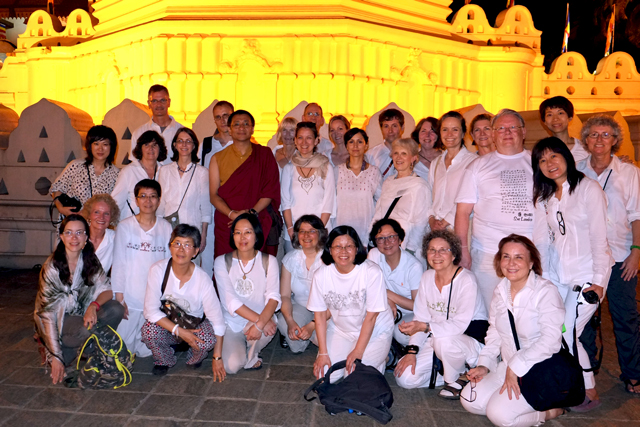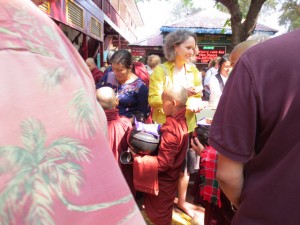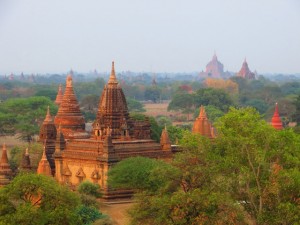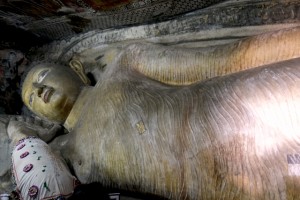A Nalandabodhi Pilgrimage to Theravadan Asia
Written by: Juli Goetz Morser

Dzogchen Ponlop Rinpoche and the Nalandabodhi sangha members before the Temple of the Tooth in Kandy, Sri Lanka.
There are some moments in life when you say yes and figure out the details later. That’s just what happened on a soggy day last November, when I opened an email inviting 30 members of our Nalandabodhi sangha to join our teacher, Dzogchen Ponlop Rinpoche, on pilgrimage to Burma (Myanmar) and Sri Lanka.
Reply. Yes. Send.
A pilgrimage by definition is a journey undertaken for paying homage to holy sites or as a quest for understanding or discovery. Though our sangha is rooted in the Vajrayana tradition of Tibetan Buddhism, our pilgrimage was to visit sacred places in Southeast Asia and to learn about Theravada Buddhism, as it exists in Burma and Sri Lanka.
Fast forward past cumbersome details and unexpected obstacles to March 3, when I found myself on a small, very loud plane flying through stacks of white cumulous clouds. Miles below the mud brown Ayeyarwady River twisted through a flat, dry, sparsely populated Burmese landscape. We were headed upcountry from Yangon, to the cultural capital of Mandalay.
Landing in Mandalay was like landing in Nebraska – acres of undeveloped grassland, some cows, oxen, and lots of wide-open sky.
But the airport was empty. Unlit. A handful of workers greeted us as we collected our bags in the semi-darkness. Outside, in the lingering light of early evening, we boarded a flamboyant red bus with pink-tasseled curtains and drove into a land of contrasts.
Gold-leaf pagodas shimmered in fields next to farmers wearing woven straw hats, guiding ox-drawn plows. Clumps of barefoot people kicked up dust by the almost-empty highway. In Mandalay, a city of 1 million, cascades of motorbikes, nondescript apartment buildings, and giant billboards permeated the busy streets, adjacent to the sacred Maha Muni Pagoda.

The group sponsored one day’s main meal for all the monks at Mahagandayon Monastery in Mandalay, Burma. Here Juli Goetz Morser hands a monk a piece of cake.
Legend says that Buddha brought the seated 13-foot high image of himself – Maha Muni – to life by embracing it seven times. Devout Buddhists call it the ”Maha Muni Sacred Living Image.” This I learned after visiting the pagoda.
What I felt before the glowing Buddha mixed a powerful outward respect for the thousands of pilgrims making offerings of pungent lotus blossoms, gold-leaf, money and prayer, with an inner stillness and vast reverence. Our group chanted the “Sutra of the Heart of Transcendent Knowledge.”
Twice we went to Mahagandayon Monastery, one of Burma’s largest teaching monasteries, first as visitors then as donors, to provide the final meal of the day at 10:30 am.
Serving the monks became a living teaching. In single file 1,500 monks robed and barefoot, gaze cast down, begging bowl in hand, silently accepted the day’s offering. The youngest – the age of romping kindergarteners in Seattle – also received only what was given, and concentrated to keep their eyes off the butter-yellow slices of cake. My heart opened wide.
Over the next two days we traveled to ancient pilgrimage sites like Mandalay Hill and Kungmudaaw Pagoda, plus state and privately-sponsored schools of Theravada Buddhism.

View from Shwesanda Pagoda in Bagan, Burma.
Every Burmese Buddhist male temporarily wears maroon robes and lives the life of a monastic. Women are not required to become nuns, yet pink robes are a common sight. With a population 89 percent Buddhist, this becomes a Burmese way of life.
A six-hour bus ride then took us southwest to the city of Bagan, but it appeared like we’d traveled backwards in time. Over 2,000 temples, pagodas, and stupas, from the ninth to13th centuries, rose up from the plains by the Ayeyarwady River.
Inside the highly revered Ananda Temple, stood four 25-foot tall Buddhas facing the four directions. Stone carvings by the hundreds filled niches in the wall. At other pagodas intact frescos depicted the Jataka tales, or stories of the Buddha’s life. As I turned into a dark temple corridor, an unexpected but palpable wave of energy washed over me, an unexplained energy, perhaps of devotion still humming within these 1,000-year-old brick walls.
Outside, horse-drawn buggies awaited passengers. Children hawked traditional Burmese long-gyia sarongs, intricate lacquerware, sandpaintings and woodcarvings. Brightly-colored narrow, wooden boats glided downriver.

Dharma talk at Nilambe Buddhist Meditation Center in Nilambe, Sri Lanka.
On top of Shwesanda Pagoda, we watched the setting sun burnish the sky like hammered gold.
On our seventh and last day we experienced the country’s most sacred Buddhist site, Swedagon Pagoda. On a 250-acre circular platform below a 322-foot high dome, countless worshippers meditated under elegant shrines, protected from the intense noonday sun.
Were they tourists? Perhaps. Pilgrims? Most likely, for it is said that all Burmese Buddhists hope to visit Swedagon at least once in their lifetime. Like us, each walked clockwise and barefoot on sizzling tiles around this 2,500-year-old gold-plated diamond-studded stupa, enshrining eight strands of the Buddha’s hair.
Flying south towards the equator, we left behind the dry plains of Burma for the humid tropics and tea-covered mountains of Sri Lanka.
As in Burma, a large segment – 70 percent – of the Sri Lankan population follows Theravada Buddhism. Unlike in Burma, monks entering a monastery expect to remain for life. We saw fewer robed monks on the Sri Lankan streets, but discovered a wealth of Buddhist heritage on this small but diverse island.

Sleeping Buddha in the Dhambulla Cave Temples in Dhambulla, Sri Lanka.
The Temple of the Tooth, perhaps Sri Lanka’s most venerated pilgrimage site, resides in the city of Kandy and houses the Tooth Relic of the Buddha.
Donned in white we arrived at dusk. A soft pink light illuminated the white temple. Visitors and pilgrims packed the entry hall, where drummers beat an almost deafening rhythm. Upstairs, the powerful reverberations passed through us, as we silently waited to enter the ornate inner chamber of the Tooth Relic Shrine.
Planted in 288 BC, the Sri Maha Bodhi Tree grew from a cutting of the original bodhi tree in Bodhgaya, India, under which the Buddha attained enlightenment. Wind blew back the heart-shaped leaves, iron crutches propped up its limbs. We circled the trunk encircled with prayer flags, making offerings and receiving blessings from the monks who carefully tend the ancient tree.
Inside the first of five caves at The Dambulla Cave Temple, our group stretched the length of a magnificent, painted, 46-foot sleeping Buddha, carved out of a single stone in the first century. Painted iconic images, viewed by mediators and pilgrims for over 20 centuries, covered the walls and ceiling. The air was thick, brimming with more than just the day’s heat and humidity.
Up a winding rutted road, past verdant tea plantations, sits the Nilambe Buddhist Meditation Center. It is a calm and serene place with cool mountain air and plentiful songbirds. Once there, we received a gracious welcome, a simple lunch, a teaching on loving-kindness, and the opportunity to meditate in the Theravada tradition.
Many wonders and rich experiences filled our days in Sri Lanka. The final pilgrimage took us up Sri Pada, also called Adam’s Peak, to a sacred rock containing the Buddha’s footprint.
We began in the middle of the night, climbing more than 5,000 stairs to reach the 7,300-foot summit by sunrise. Older women, barefoot in white dresses, passed us as they descended, pilgrimage completed. Families with young children, teens in flip-flops, folks of every size, shape, and age worked their way upward.
Buddhists, Hindus, Christians and Muslims all revere the footprint and in the early hour two ceremonies, one Buddhist one Hindu, honored the hallowed impression. Guides nudged our elbows and pointed to a spot west of the mountain, where a perfect silhouette of the summit floated above the morning mist.
In the end our pilgrimage paid homage to many astonishing sites and we witnessed many aspects of the living Theravada Buddhist tradition. Yet if a pilgrimage journey also is said to be its destination, then the opportunity to travel with our teacher, Dzogchen Ponlop Rinpoche, was perhaps the true destination, and for that I am profoundly grateful. Sometimes you just have to say “yes”.
Photos by: Lynn Archibald, Lela Chavez, Violet Lee, Cynthia McCormack and Juli Goetz Morser










